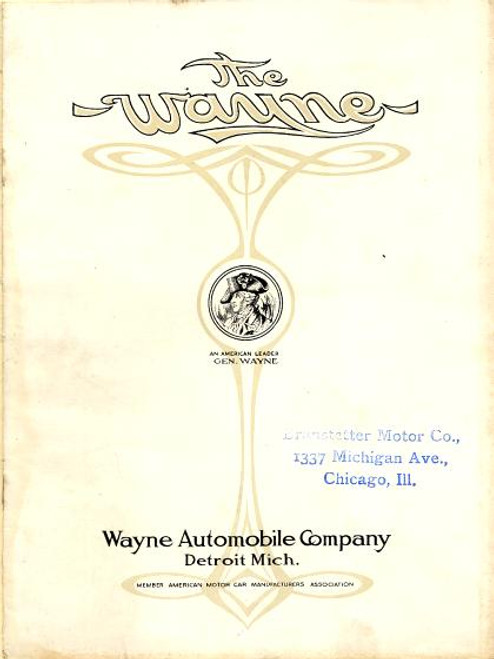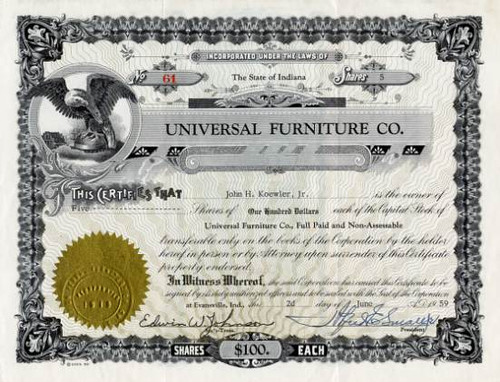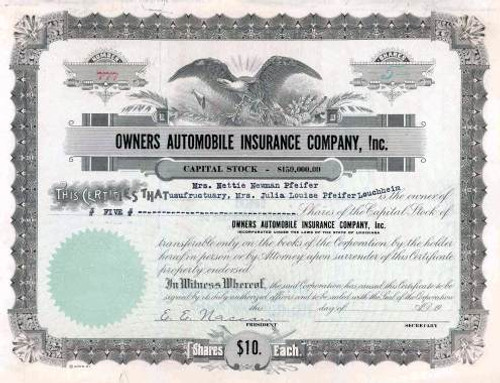Beautifully engraved certificate from the Simca issued in 1959. This historic document was printed by the Security Banknote Company and has an ornate border around it. This item is hand signed by the Company's Authorized Officer and is over 47 years old. Henri Théodore Pigozzi was born on the 26th of June, 1898. In 1922, Pigozzi met Carlo Carmone, who introduced him to Giovanni Agnelli, the founder and patron of FIAT. Pigozzi started to send auto carcasses to FIAT foundries in Turin for recycling! In 1924, Pigozzi became a general agent for FIAT in France and, in 1926, started a distributorship for FIATs called SAFAF (Société Anonyme Français des Automobiles FIAT). The organization started to assembly FIATs in a plant in Suresnes (on the edge of Paris) from mechanical parts, which either had been imported separately, or built under license in Paris. From 1928 to 1934, approximately thirty thousand FIATs were assembled and sold by Pigozzi! At the end of 1934,Pigozzi, the former scrap merchant, while passing by chance on the road which goes from Paris to Saint-Germain, noticed a poster which announced the sale of the old Donnet-Zédel factory. The condition of industry in France in those days was certainly not flourishing, but nevertheless, Pigozzi acquired the installation. On 2 Nov 34, La Société Industrielle de Méchanique et de Carrosserie Automobile, SIMCA, was formed with FIAT at 163 to 185 Avenue Georges Clemenceau, in Nanterre. All this was a remarkable financial sacrifice, just at a moment to which most in his situation would have acted with much greater prudence. The actions of Pigozzi, even if it apparently hazardous, were actually supported by a well prepared plan: it was precisely the difficult situation of the national market which had encouraged him to estimate that by offering the public a variety of small-engined, popular cars at a moderate price, it would become a great commercial success. FIAT already produced the 508 Balilla, which approached the ideal of Pigozzis promised success, but FIAT also had a small car project, the 500 Topolino, with even more economic and utilitarian characteristics. The Société Industrielle de Mécanique et Carrosserie Automobile was founded by Henri Théodore Pigozzi, who started by assembling FIAT cars like the Topolino 500 (later sold under the name of SIMCA 5) and the 508 (SIMCA 8) for the French market. The purchase of and activities at the 50 000 m² factory at Nanterre began in 1935 and, for a short period, it was limited to the assembly of the FIAT 508 Balilla, sold under the FIAT FRANCE mark. The principal objective for creating the SIMCA company was achieved in 1936. Of 204,000 vehicles produced in France in that year, approximately 7,300 were of a new mark which had begun to produce French cars. They were SIMCA''s. SIMCA introduced a French version of the FIAT Topolino, called the SIMCA Cinq (5) and it gained great popularity in Europe and abroad. The first year of activity represented a remarkable result, but it certainly did not make it possible to envision the powerful developments that the new company would engage in. In April 1936, the first SIMCA-FIAT came out, the faithful counterpart of the 500 Topolino. With the differences like that which occurred for the Balilla and preceding FIAT models, the new SIMCA-FIAT, called Cinq (Type 5), was built completely in France, although being based on the FIAT projects of which Pigozzi and his technicians were familiar from the factory of Turin. This first SIMCA had an engine with four cylinders, in line, of 569cc, side valves, power of 13 hp and a top speed of 53 mph (85 km/h). The price of ff 9,900 was definitely competitive. The success of this small car in France could have been much larger if trade-union agitation's on several occasions had not interfered with its production. The SIMCA plant overlooks Nanterre, just outside Paris. It spread out its white factory buildings and ivy covered constructions in impressive array. Not only modern in design, the SIMCA plant was the latest work in tooling equipment and industrial efficiency. The 4,000 men and women working in the SIMCA plant used the most up to date specialized machine tools in France. Most of these machines had been built in order to turn out specific work. This made possible surprising speed and accuracy. SIMCA experts devoted thousands of hours of study to simplifying the operations and increasing the efficiency in the shops. Nothing was overlooked in order to get quality first. Every phase of car construction underwent rigid inspection. This continuous inspection was also a guarantee of continuous quality. A total of 58,400 SIMCA 5 and SIMCA 8 models were manufactured from April 1936 (when SIMCA began to sell under it's own name) and the outbreak of the war in September 1939. In December, 1937, under an agreement with FIAT, a rebadged FIAT 508C (Belilla) rolled off the assembly line at the old "Donnet" factory by the Seine. It was quite a hot number and was used to power many victorious European racers. Among the unique features of the 1100cc car was the absence of central door pillars. From this point on, these cars were no longer called SIMCA-FIAT, but simply SIMCA. Like the preceding model (the SIMCA-Cinq), this one also had a numerical denomination: SIMCA-Huit (8). The engine was 4-cylinders in line of 1,098cc with 32 hp and a top speed of 69 mph (110 km/h). In 1938, SIMCA's production tripled. Production of the SIMCA Cinq peaked in 1938 with 14,194 specimens. A total of 227,000 automobiles were produced in France in 1938. The war: The release of the conflict marked practically the end of the first cycle of production of SIMCA, whose activity was reduced beginning in 1940, even if it never ceased completely throughout war. The SIMCA-Deho sports car was shown in 1939. At the end of 1939, an assessment was made of the first five business years, and was primarily positive. Indeed, SIMCA, had produced almost 70,000 cars and, thanks to the advised management of Pigozzi, its outlook was also good! Outside of France, the brand was quite successful in competition, particularly the Amédée Gordini modified 508 with a 28hp Topolino motor and the 508 C, with aerodynamic 2 seat body amd 28hp Topolino motor, which won several races, the Bol d'Or, la Course de Reims for small sports cars, the Paris-Nice rallye and the 1939 Course du Mans. In 1942, Simca acquired the Groupe Francais Automobile du Baron Retiet, an organization associated with the Delahaye and the Delage. After the war, SIMCA was one of the first plants to be rebuilt out of the catastrophe of the conflict. During World War 2 there was no private automobile production in France. In December 1944, SIMCA was chosen by the American Army to overhaul Jeep motors and to manufacture spare parts and gasoline jerricans. A total of 35,000 automobiles were produced in France in 1945. SIMCA resumed automobile production in 1946 and produced its pre-war models (Balilla Tipo 508, Ardita Tipo 518, SIMCA 5 and SIMCA 8) with modifications and improvements until 1951 and in this period, 194,169 behicles were turned out. The factory of Nanterre started again to function and, in fact, produced more than 8,000 cars during 1946. There were the two models in of the pre-war period, but Pigozzi was already designing a car which SIMCA would build without the assistance of FIAT. Collaboration with Italy did continue, however, for a few years and, in 1949, lead to the launch of the overhead-valve engined SIMCA-Six, a French version of the FIAT Topolino C. During this time, the rate of production of the SIMCA-Huit was on the increase and one could obtain it in five versions: sedan, convertible, wagon, light van and van. This model was also equipped with an engine with a cubic capacity slightly higher than the Italian original (1,200 cc and 40hp). 1947 SIMCA Achievements: "The quality of a car must be proved on the road and in open competitions. In all long-distance and endurance contests, in all races, SIMCA Huit has been in the lead since 1938. Gordini's team notably, won overwhelmingly with SIMCA Model 8 in all international major events: Bol d'Or - 1938, Monte Carlo Rallye - 1939, Le Mans 24 hour race - 1939, Paris Grand Prix - 1945, Nice Grand Prix - 1946, Marseille Grand Prix - 1946, Forez Grand Prix - 1946, Saint Cloud Grand Prix - 1946, Dijon Grand Prix - 1946, Nantes Grand Prix - 1946, French Alps - 1946, Nimes Grand Prix - 1947, Marne Grand Prix - 1947, Paris Cup - 1947, Isle of Man Grand Prix - 1947, Bol d'Or - 1947. Drinks like a hummingbird...! Since the first day it was created, the Five Liter Race (1.32 gallons) a classic low gas consumption test - has always been won by SIMCA. During the last Five Liter Race, SIMCA's achievement was particularly brilliant: 60.15 mpg by traveling 79.4 miles on 1.32 gallons of gas. In October 1948, production of the overhead-valve SIMCA 6 began. The year 1949 saw the introduction of the SIMCA Sport version of the 8. It had 50hp, and beautiful coupe bodywork by Facel Metallon and was planned for competition in Alpine rally's. A total of 230,000 automobiles were produced in France in 1949. 15,584 were SIMCA Huit's, and SIMCA's percentage of the total medium priced cars in France was 15.2% andSIMCA's percentage of total cars in France was 11.4%. Total SIMCA production in 1950 equaled 66,000 units. The SIMCA-Huit sedan was transformed and reintroduced with a 40hp, 1,200cc motor and the gearshift moved to the column. The SIMCA-Huit could still be had in a sports version, having 52 hp. The engine of the 1100 SIMCA 8 was enlarged to 1,200cc. A total of 290,000 automobiles were produced in France in 1950. 27,177 were SIMCA Huit's and SIMCA's percentage of the total medium priced cars in France was 17.5% and SIMCA's percentage ot total cars in France was 11.1%. In 1950 year the Simca 8 was restyled, and emerged with a 40bhp 1.2-litre engine and steering-column change. In the summer of 1951, however, an entirely new car, the Aronde, made its appearance; the engine was a 45 hp derivative of the old 8CV, but the rest of the car was entirely new, with unitary construction, coil-and-wishbone independent front suspension, and hypoid final drive. The Aronde had a production run of over 12 years. In the course of the years Simca took over several companies including Unic (now only making trucks) in 1951, Ford France S.A. in 1954 and Talbot in 1959. With the acquisition of the French Ford company, the Ford 2.3-litre side-valve V-8 Vedette reappeared under the Simca name. Simca later moved into the Ford factory at Poissy and sold the original Simca works at Nanterre to Citroen in 1961. The V-8 sold fairly well, and was given a more powerful 84 hp engine in 1958. Production ceased in France in 1961, though as late as 1967 the Chambord and Presidence versions, now with a ohv engine producing 112 hp, were still being made under licence in Brazil. 1956 Arondes had 48bhp 1.3-litre engines as standard, though 57bhp Special units were found in the sports coupe's and convertibles and the Montlhery saloon; station wagons had the 45bhp Service type. 1957 saw a family derivative, the Ariane, using the hull of the V-8 Vedette and the regular Aronde engine - it was made until 1963. In 1958 Chrysler acquired a minority interest in Simca, and by 1967 the Chrysler 'pentastar' emblem was to be seen on all Simcas. Aronde development continued: a cheap 6CV 1,100cc model was listed in 1960, and the 1961 range used 5-bearing engines in various ratings up to 62bhp, later increased to 70bhp. A new departure for 1962 was the 1000, a 944cc rear-engined 4-door saloon with radiator mounted alongside the power-unit, 5-bearing crankshaft, all-round independent suspension, and 4-speed all-synchromesh gearbox: at 6,490NFr it was cheaper than Citroen's Ami 6, and production rose to over a quarter of a million cars. 1964 was the last year of the Aronde, which had been continued as a very inexpensive item at 6,950 NFr for an 1.100cc saloon. In 1968 Simca switched to front-wheel drive with their transverse-engined 53bhp 1100. In 1970, the company changed its name and the Chrysler 160/180/2L was added as a prestige line. Also Simca took Matra, and their racing team, under their wing. The principal novelty for 1972 was yet another 1000 derivative, the 1,294cc Rallye saloon. The conventional rear-driven 1301 and 1501 were continued into 1973, along with the 1000 and 1100 families. History from Wikipedia and Encyberpedia.
Simca Automobile Company 1959
MSRP:
$59.95
Was:
Now:
$39.95
(You save
$20.00
)
- SKU:
- simca
- UPC:
- Gift wrapping:
- Options available in Checkout

Add to Cart
The item has been added
Societe Des Automobiles Simca ( Chrysler logo) - France 1967
MSRP:
$69.95
Was:
Now:
$49.95

Add to Cart
The item has been added
Wayne Automobile Company - Detroit, Michigan 1907
MSRP:
$249.95
Was:
Now:
$199.95

Add to Cart
The item has been added
Taft Broadcasting Company - Delaware 1959
MSRP:
$395.00
Was:
Now:
$295.00

Add to Cart
The item has been added
California Electric Power Company - 1959
MSRP:
$49.95
Was:
Now:
$39.95

Add to Cart
The item has been added
Tivoli Brewing Company - Colorado 1959
MSRP:
$34.95
Was:
Now:
$24.95

Add to Cart
The item has been added
Universal Furniture Company - Indiana 1959
MSRP:
$39.95
Was:
Now:
$29.95

Add to Cart
The item has been added
Salt Lake Automobile Speedway Company - Utah 1912
MSRP:
$395.00
Was:
Now:
$295.00

Add to Cart
The item has been added
Owners Automobile Insurance Company, Inc. 1927 - Louisiana
MSRP:
$69.95
Was:
Now:
$49.95

Add to Cart
The item has been added
Packard Motor Car Company - Famous Automobile Maker
MSRP:
$54.95
Was:
Now:
$34.95





